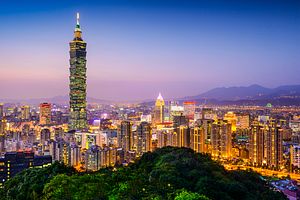Asia may have dodged an economic bullet from the U.S. Federal Reserve, but the region’s increasingly wealthy and urbanized cities are among the world’s most exposed to disasters, a new study says.
Based on research undertaken by the Cambridge Center for Risk Studies, insurer Lloyd’s “City Risk Index 2015-2025” has identified some $4.6 trillion of projected gross domestic product (GDP) at risk of manmade and natural disasters in 301 major cities over the next 10 years.
Worryingly for the region, the list is dominated by Asian cities, with Taipei ranked top with $181 billion of GDP at risk, followed by Tokyo’s $153 billion, Seoul’s $103 billion and Manila’s $101 billion. Osaka ranked eighth with $79 billion at risk, followed by ninth-placed Shanghai with $78 billion and Hong Kong’s $75 billion, while Singapore (18th) and Jakarta (20th) completed Asia’s dominance of the top 20 riskiest cities.
According to Lloyd’s, the top five global threats are a market crash, with more than a trillion dollars of GDP at stake, followed by human pandemic ($591 billion); wind storm ($586 billion); earthquake ($464 billion); and flood ($432 billion). However, new or emerging risks such as cyber attacks are also increasingly significant, it said.
For Taiwan’s capital, a wind storm poses the top threat with nearly half of its GDP at risk, followed by an earthquake or market crash hitting the city of 2.6 million people. With typhoons a regular occurrence – Typhoon Morakot killed at least 40 people in 2009 – Taipei is also exposed to regular flooding, along with nearby volcanoes such as the Tatun group being located just 15 kilometers north of the capital.
Taiwan has already suffered a spate of manmade disasters in 2015, including fires, plane crashes and gas pipe explosions, with a government spokesman blaming “insufficient awareness” of safety risks.
Japan has suffered a trifecta of natural disasters this month, including earthquakes, flooding and volcanoes. Lloyd’s warns of more to come, with Tokyo facing the biggest risk from wind storm ($29 billion), market crash ($23 billion), and oil price shock ($21 billion), followed by quake and flood disasters.
In a September 21 report, the Japan Times said the city of 38 million people is facing the prospect of a disastrous flood event, worsened by the risk of climate change. “It’s just a matter of time before Tokyo is struck by the same magnitude of flooding that devastated parts of the northern Kanto region this month…should the capital remain unprepared it will most likely be ‘annihilated’,” the Japanese daily said.
However, Lloyd’s was less alarmist, describing the Japanese capital’s risk exposure as a proportion of annual average GDP as a relatively modest 10 percent, due to its wealth.
In its latest Safe Cities Index 2015, the Economist Intelligence Unit rated Tokyo as “the most populous but also the safest city among the 50 surveyed worldwide, followed by Singapore and Osaka.”
Meanwhile, third-riskiest Seoul also has the highest risk from wind storm at nearly $45 billion, “owing to its location in the North West Pacific typhoon belt.” Other major risks for the South Korean capital include an oil price shock ($12.7 billion), market crash ($12.6 billion), flood and human pandemic, while the city of 10 million people also has the world’s highest exposure to drought.
Yet after recently suffering a breakout of the MERS infection and previously the Sewol ferry disaster, Koreans have become accustomed to threats in recent times.
Fourth-riskiest Manila’s biggest threats are natural disasters, led by wind storm ($60 billion), quake ($13 billion), volcano ($5.8 billion) and flood ($5.5 billion), highlighted by the disastrous Typhoon Haiyan, which killed more than 6,000 people in 2013. The city is located on the edge of the Ring of Fire, adding to its quake, volcano and tsunami risks, while it also faces manmade threats such as a human pandemic, market crash or oil price shock.
Worryingly for the Philippines, the capital’s economic exposure as a proportion of average annual GDP is the world’s highest at over 50 percent, making safety measures imperative for the city of 13 million.
Emerging economies such as the Philippines are set to shoulder two-thirds of risk-related financial losses as a result of their accelerating economic growth, with their cities often highly exposed to single natural catastrophes, Lloyd’s said.
With Asia’s urbanization still continuing and amid an increasing intensity of natural disasters, the region faces an important challenge in strengthening its resilience, the insurer said.
“The findings show the need for governments and businesses to work together to build more resilient infrastructure and institutions. How quickly a city recovers after a catastrophe is a key component of the total risk, and the impact of events is mitigated by rapid access to capital to help restore the economy,” Lloyd’s said.
Preventing disasters might be impossible, but the world’s fastest-growing region has never had more at stake.

































